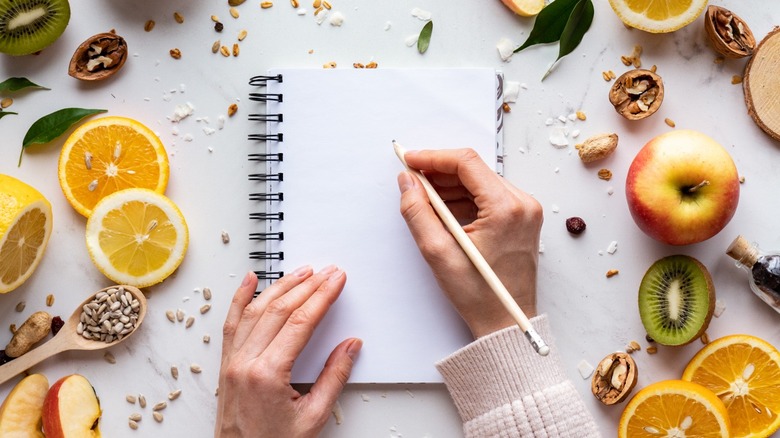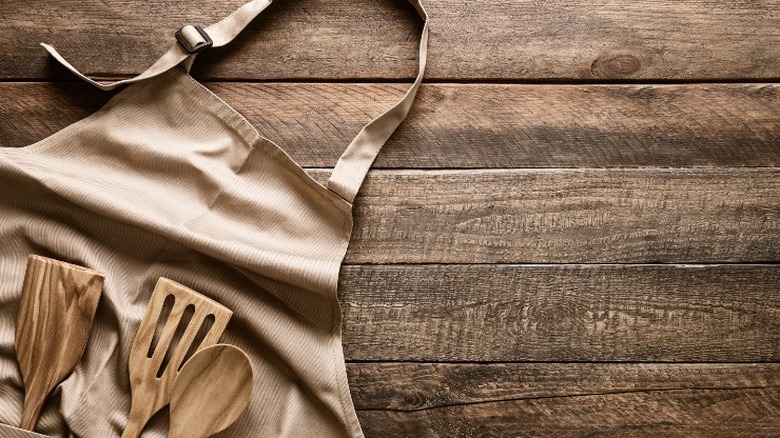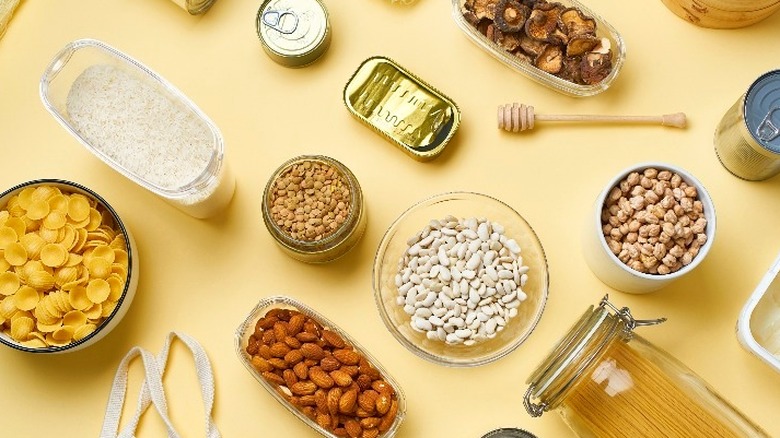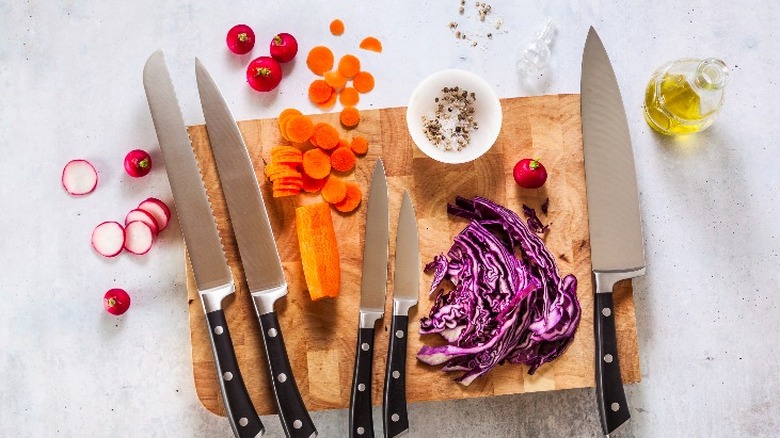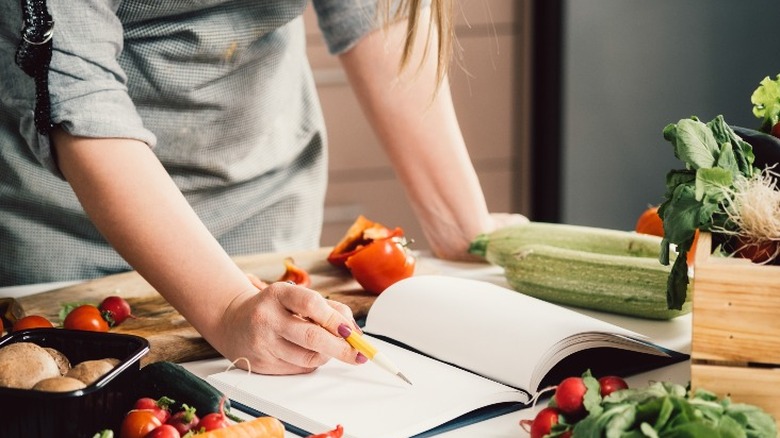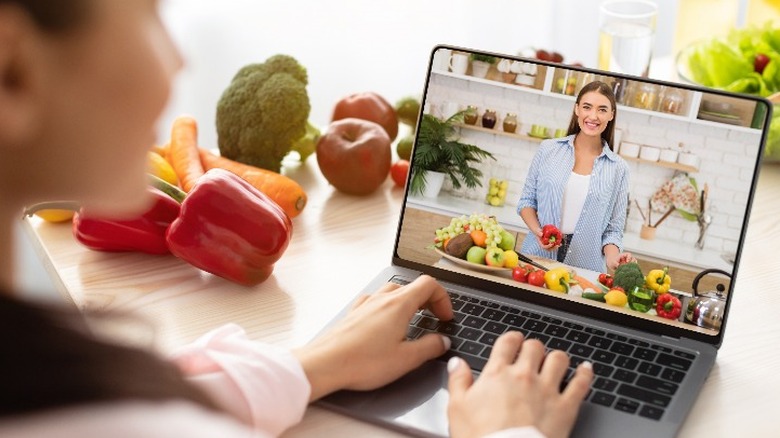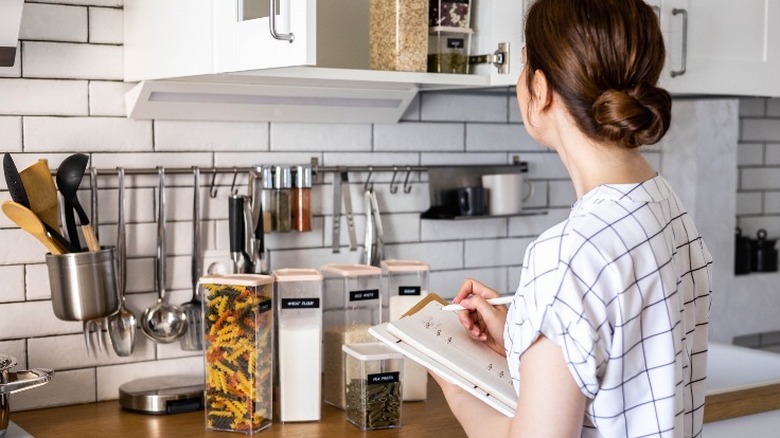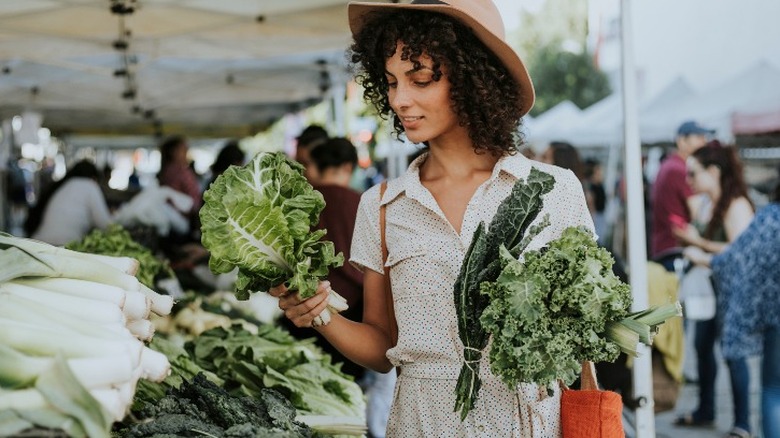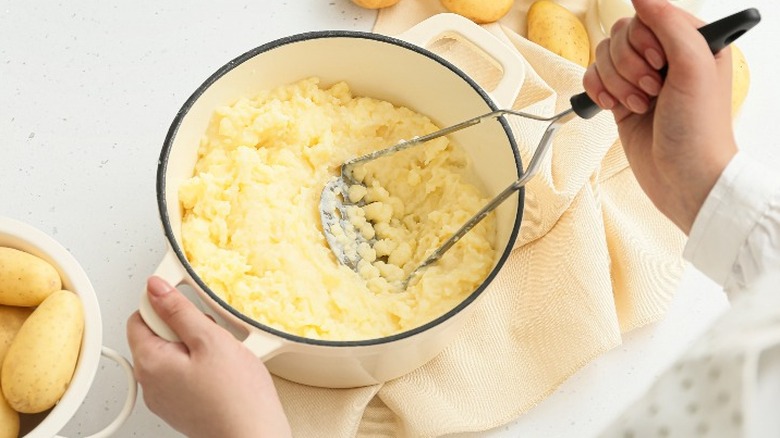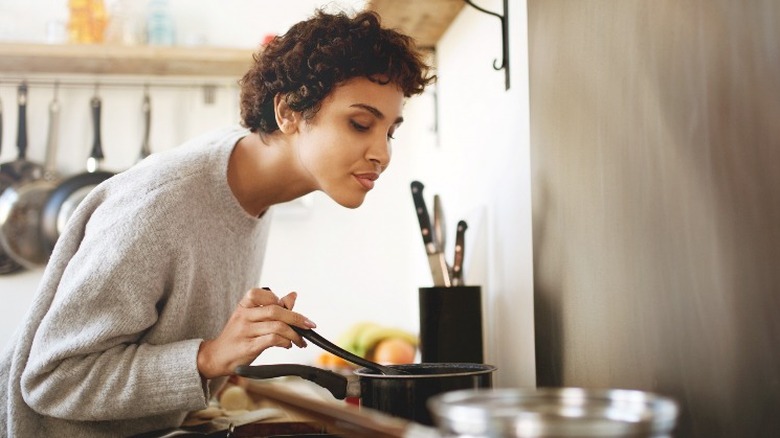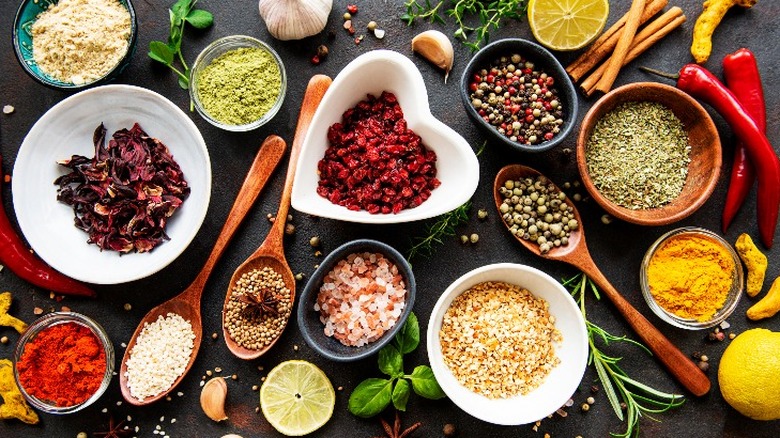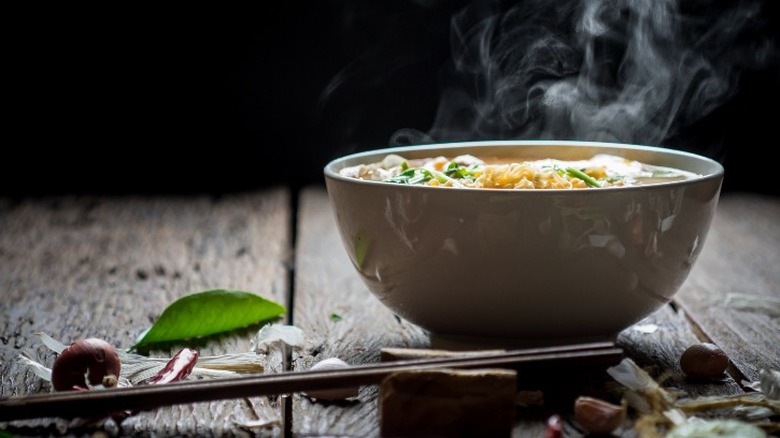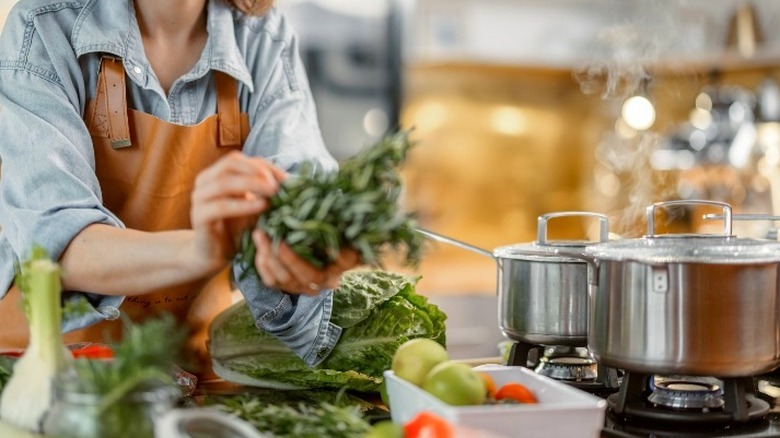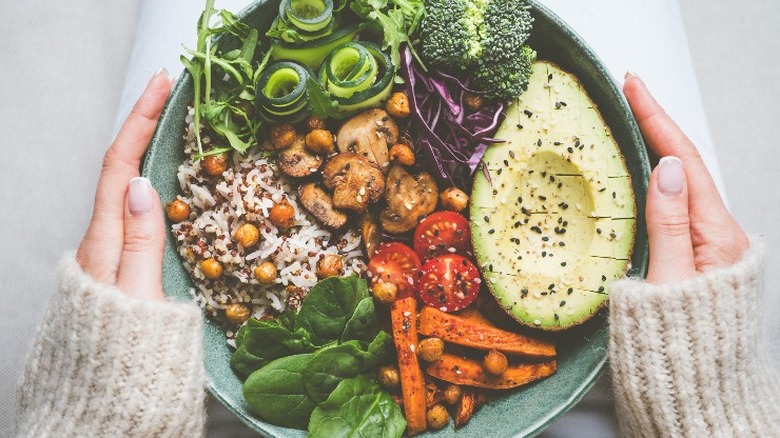14 Ways To Polish Your Own Unique Cooking Style
In the kitchen, your unique cooking style is what sets you apart. With the right techniques and ingredients, you can easily create flavorful dishes that reflect your personality. Rigid recipe following aside, cooking is a highly creative, intuitive, and sometimes chaotic process that gratifies. Developing and polishing your unique cooking style (that doesn't rely on recipes) is about sharpening your culinary mind alongside your cooking abilities and food knowledge base.
Whether you're an amateur cook or a seasoned chef, there are a few simple ways to embrace the era of no-recipe cooking and become more intuitive with your everyday meals. By studying the basics via books and blogs, mastering common plating techniques, and experimenting with new flavor combinations, you can develop your culinary knowledge and skill and take your creations to the next level. With each new plate you create, your loved ones (or Instagram followers) will be able to appreciate the special touches you've added to make it your own. So, let's get started on the path to developing your unique cooking style — and if you enjoy experimenting in the kitchen and following your gut, you're already halfway there.
Define your cooking style
The first step towards developing your own cooking style is putting it into words. What is it, anyway? It's not quite the same as a cooking method, which usually focuses on a specific technique. It's different from your favorite cuisine, too. A cooking style is personal and unique and can range from innovative, modern, and gutsy to simple, relaxed, and hands-off. It can be sophisticated or frugal, contemporary or traditional, influenced by roots and upbringing, or focused on a host of staple ingredients.
If you need help defining your style, consider what you like about food and cooking and look for similarities in the cuisines you most enjoy. Is it the bold flavors, the ingenuity, or a sense of comfort and nostalgia that cooking brings you? Answering this question will get you one step closer to defining your style.
Alternatively, look to your favorite celebrity chefs. How did they become so famous, and who do you identify with the most? For example, there's Jamie Oliver's healthy yet delicious awareness-raising approach; David Chang's hearty Asian-inspired dishes full of integrity; and the scientific style of Heston Blumenthal. If you've ever wondered what Ina Garten thinks about her own cooking, she describes it as elegant, simple and focused on essential flavors. Fortunately, there's no shortage of food personalities you can base your cooking style on, so look your favorite ones up and analyze them.
Stock up on staples
If you're a fan of food blogs and cookbooks, you might find yourself always shopping for specific recipes. That often results in a host of mismatching leftovers, such as a barely used jar of capers or half a cabbage. In contrast, cooking without recipes relies on a well-stocked pantry. Think of the ingredients you always have on hand. Can they be combined to make a full meal? Are there any new and unexplored ways you could use them?
Shop outside your go-to perishable foods and invest in lasting staples. Basic ingredients you should always have on hand include onions, garlic, lemons, and olive oil. Together with salt, pepper, and sugar, they will make anything you cook balanced and flavorful. Dried legumes, whole grains, pasta, and vegetable broth are always listed among the staples every vegan cook needs to have, but this can be applied to everyone. Internation cuisines offer other staples that will instantly improve your dinner game — think of all the dressings, sauces, and marinades you can make with tahini, miso, or gochujang. As time goes by, your personal list of staples will become more refined. But as long as you ensure your kitchen is well-stocked with them, the flow of your improvisational cooking will be smooth.
Know the basics
Being able to cook without a recipe is a skill to acquire. Developing your kitchen intuition directly relates to how well you know the basics. For example, do you know what flavors go well together, what are the most common cooking techniques, and how to store your produce properly? While culinary training is not necessary to become a confident home cook, knowing this stuff is.
First, get a general sense of proportions — for instance, learn the standard vinaigrette formula, where the ratio of fat to acid is 3:1. Next, learn the basics of food science, which will explain the origins of the Maillard reaction, among other things. Books like "Mark Bittman's Kitchen Matrix" can help you with both. Food safety is another important thing to educate yourself on, especially if you tend to get carried away in the kitchen. Finally, study recipes to see commonalities and use those as road maps to inform your cooking in terms of ingredient combinations and kitchen techniques. Knowing these things will make you more confident in the kitchen and turn cooking into an enjoyable process rather than a laborious task.
Keep notes
Improvising in the kitchen is fun, especially when it works out. But it's hard to repeat past victories if you don't keep track of your process, so the importance of taking notes should not be underestimated. Julia Child thought so, too — and that's why her method for writing recipes was revolutionary. Her iconic tome, "Mastering the Art of French Cooking," provides home cooks with detailed yet clear instructions that leave no space for guessing. But cookbooks weren't always this way.
With the current rise of no-recipe cooking, we're headed back to the times of early cookbooks, which included only the most basic and brief instructions. Their authors assumed that the reader already had a fundamental understanding of cooking and didn't need to go into more detail. And with all the food content available these days, that might also be true for modern home cooks. However, experimentation deserves to be tracked, whichever way you want — on your phone's notes app, a recipe journal, or a note card. No matter how confident you are in the kitchen, providing your future self with detailed observations and instructions will be helpful.
Find recipes you trust
It's okay to rely on cookbooks and food blogs when you're starting out. Tested recipes from trustworthy sources are a great base on which to build your personal cooking style. You can get inspired by one of the cookbooks everyone should have, such as "Chez Panisse Café Cookbook" by Alice Waters or "Plenty" by Yotam Ottolenghi. Once you've covered the essentials, feel free to move on to the books that focus more on intuitive cooking. Book Riot recommends Samin Nosrat's "Salt Fat Acid Heat" and Mark Bittman's "How to Cook Everything," among others. And, of course, there are always cooking shows and food creators online you can learn from and identify with.
Once you find the resources that work for you, follow their best practices and immerse yourself in the flavors, cuisines, and techniques they suggest, then go on to make them your own. Start slow, and change one thing at a time until you've perfected a dish to your liking.
Organize your kitchen properly
Counterintuitively, the ability to improvise a meal from scratch hugely depends on organization and planning. In addition to making sure you always have a well-stocked pantry, you need to get control over your workspace. Being comfortable in your kitchen is the main ingredient for stress-free cooking, so feel free to arrange it in a way that makes sense for you. Or take professional advice, and organize your kitchen like a chef.
First, eliminate the need for any extra movement. Mentally dividing your kitchen into different stations (where you store, prep, cook, wash, and serve) and focusing on working in one can help. The essential tools every kitchen must have should also always be within reach, but in a way that makes sense for the dish you're making. Don't clutter your workspace with things you don't plan to use, and find an appropriate home for all your utensils. Get good equipment if you can because it will make your cooking process more streamlined. Finally, invest in some stackable food containers, and fill them with pantry staples, prepped ingredients, and leftovers. With a well-organized space, you'll be on your way to fuss-free cooking in no time.
Look for inspiration everywhere
If you're stuck in a rut or are simply out of new ideas, and the meals are getting repetitive and boring, don't fret, as this happens to everyone. The solution? Looking to the outside world for inspiration. Fortunately, there are many places you can find it, and some of them don't even involve leaving your house.
Location and season can be very inspiring, so going to the nearest farmer's market with seasonal produce is a great place to start. Travel when you can; when you can't, study cooking methods of different cuisines online. Cook with a friend or family member, and learn from them. Go to restaurants that always hit the right spot but do so mindfully: ask yourself, what about these places and their food makes them so appealing? If you don't feel like leaving the house, get cozy with one of the few books every food lover should read and cook vicariously through them. Alternatively, get inspired by binge-watching some of the best cooking shows on Netflix — what you learn from "Salt Fat Acid Heat" and "Chef's Table" can reawaken your passion. Keep an open mind, and let culinary inspiration find you.
Don't be afraid to improve your go-to recipes
If it ain't broke, don't fix it. Right? Wrong. You can make any basic recipe on your own, and it's better to start with something you're already familiar with. Knowing why the ingredients of a tried and true dish perform a certain way will inform your improvements. Make it more nutritious, veganize it, switch the cooking method, and add ingredients from a different genre. Pick a recipe you know intimately and use it as a fail-safe base to build upon instead of going for complicated new recipes.
Comfort classics like oatmeal or mashed potatoes are a good place to start. For example, cooking your grains in tea is a surefire way to transform your oatmeal. You can take it further by adding nuts, seeds, and frozen berries to make it more nutritious. If you're feeling adventurous, top your oatmeal with tiger nuts. Though adding these root vegetables might seem unconventional, it will change your oatmeal forever. But you don't always have to go for unfamiliar ingredients to make a difference — mashed potatoes lovers say this can be elevated with one simple swap: sour cream. Alternatively, a pinch of ground nutmeg will do if you're going through your spice rack in search of a last-minute flavor boost.
Pay attention and trust your senses
Following a recipe might seem more manageable than improvising because all the steps are laid out, and you know what to expect. However, equipment, ingredients, and even tastes differ, so the recipe descriptions or photos might not reflect what you see in front of you. In order to combat this issue, you need to cook and season mindfully and watch how the texture, flavor, and look of the food change as you do.
Sense of smell is one of the most important tools at your disposal. Not only can it aid in determining whether something's wrong, but it also plays a major role in our perception of taste. It can also guide you through the world of spices and seasonings. If you're a novice, the rule of thumb is to add a little, taste as you go, and gradually add more if desired. Finally, keep the balance of flavor in check. To do so, Le Cordon Bleu recommends paying attention to the five flavor elements: sweet ingredients reduce spiciness, and acidic ingredients counter it; salt can enhance sweetness, and bitter flavors can contrast it. If a savory dish is too bland, up the umami. Over time, this knowledge will transform into muscle memory, and you'll be able to cook and season your food without relying on outside sources.
Experiment with flavor combinations
You can make a decent meal with only the basic flavorings — salt, black pepper, oil, an acidic ingredient, maybe a sprinkle of sugar to balance something out, or a bit of soy sauce to increase umami. But what if you go beyond the basic tastes? Experimenting with flavor combinations is one of the best ways to polish your personal cooking style. For inspiration, turn to iconic flavor pairings and figure out what you like about them. Additionally, let what you observe in restaurants, supermarkets, and various cuisines educate you on which flavors work well together.
If you need more in-depth information on how to pair flavors together, pick up a copy of "The Flavor Bible" or "The Flavor Matrix." Start with a few basic ingredients and get creative. Don't be afraid to try out different combinations. You may find that something you thought wouldn't work together actually produces a delicious result! Use your intuition to transform evidence-based combinations and make them your own. And who knows — you might even discover your signature dish in the process.
Let one meal flow into another
Letting one meal flow into another is a great way to improvise in the kitchen and save time, money, and food. The best part about it is that you can rely on your intuition to create something new and delicious from what's already in your fridge. Natasha Pickowicz's soup mother is a great example of this approach. It stems from the age-old concept of perpetual stew, where the pot would rarely be completely emptied, and the leftovers were used as a base to build new dishes.
In addition to being intuitively frugal, reusing your leftovers could be a moment where your culinary creativity shines. There are several ways to breathe a new life into leftovers, such as adding new textures and flavors, changing the volume and substance of the dish with sauces and greens, mixing odds and ends into soups or curry, or turning them into tapas to eat as an appetizer. This cooking style is also a great way to save time in the kitchen, as you can quickly turn your leftovers into a delicious meal.
Master the art of substitution
The beauty of intuitive cooking is that you don't have to follow all the rules. Sure, it's essential to understand the basics, but using ingredients you don't enjoy is not a must. With a bit of creativity and intuition, you can substitute ingredients to make a dish your own. Take the classic tuna salad — you don't have to make it with canned fish if you don't like it or can't eat it. You can use chickpeas as an easy swap (that will also turn it vegan).
When substituting, the idea is to think about what a particular ingredient brings to a dish and try to find the best match in terms of flavor and texture. For example, if you're substituting coconut milk with soy or almond milk, you might need to add a thickener to compensate for losing that thick texture. Or, if you're using nutritional yeast or tomato paste as a soy sauce substitute, you will need to add a bit more salt to the dish. Don't be afraid to substitute when necessary or when creativity strikes — it's the best way to find your own individual style of cooking.
Express your style through presentation
Learning how to plate food is essential for any cook who wants to take their dishes to the next level. Basic food presentation techniques can help you create visually stunning dishes. The good news is, you don't have to be a professional chef to plate like one. WebstaurantStore recommends keeping five main concepts in mind: treating your plate as a canvas, using the rule of thirds, stimulating the appetite with visual cues, painting with sauce, and building with garnishes. With a little practice and experimentation, you'll find what works best for you.
As you develop your go-to plating methods, you'll find that it becomes an expression of your unique cooking style. It's like an extension of your personality and an outward representation of who you are as a cook. Even if you don't cook much, learning some plating tricks that will make serving snacks easier is still worth it. Humans are visual creatures who eat with their eyes first, so always pay attention to the visual features that can make food look more appealing, such as symmetry, form, freshness, sheen, and an eye-catching display.
Eat your failures – or at least learn from them
Intuitive cooking, like developing your recipe-free culinary style, requires a fair share of experimentation, not all of which will go according to plan. Learning what works without experiencing what doesn't is impossible. But failing in the kitchen is not a bad thing. On the contrary, it will help you establish your culinary boundaries and allow you to learn from your mistakes. Through each unsuccessful attempt, you can gain further knowledge of how to improve.
If you want to experiment while avoiding food waste, make small batches for one or two servings, just enough to grasp how the experiment is going. Not all of them will be a complete success, but usually, you will be able to create something usable. Find creative ways to repurpose what didn't come out right. Let your friends and family provide feedback, and let their experience and opinion inform your changes. With practice, you'll eventually learn to avoid common mistakes when making soup, pasta, or other everyday meals and move on to cooking them without ever having to look up "how to rescue overcooked veggies."
